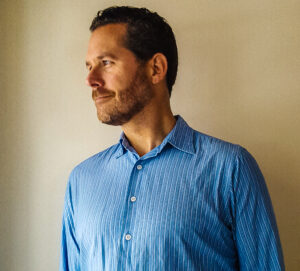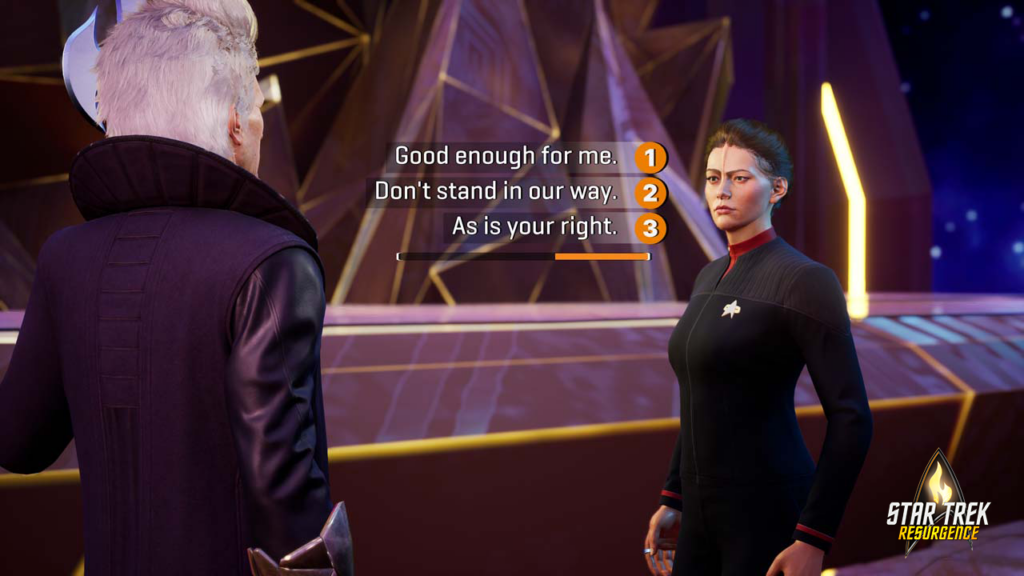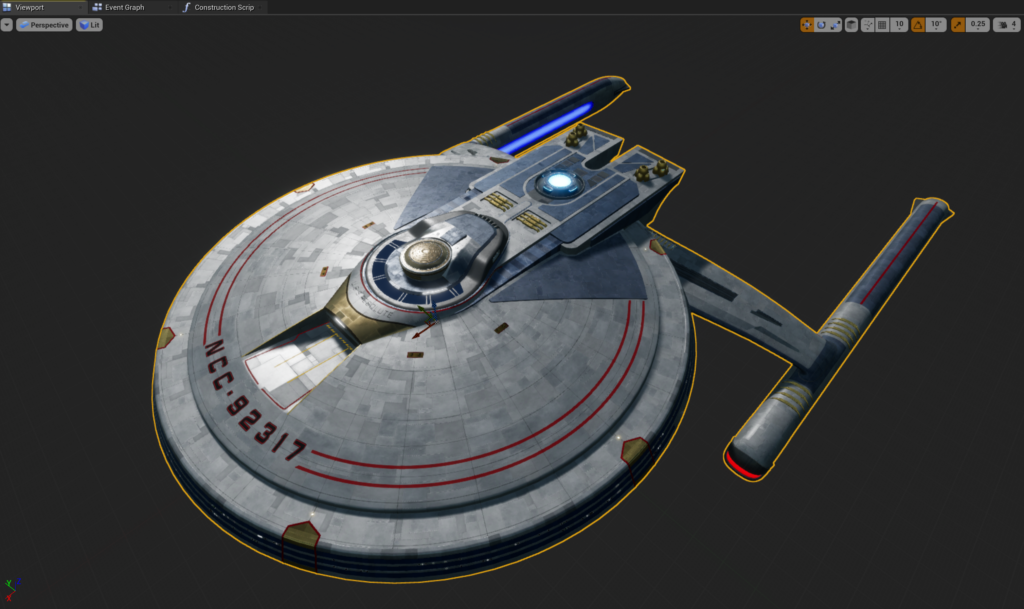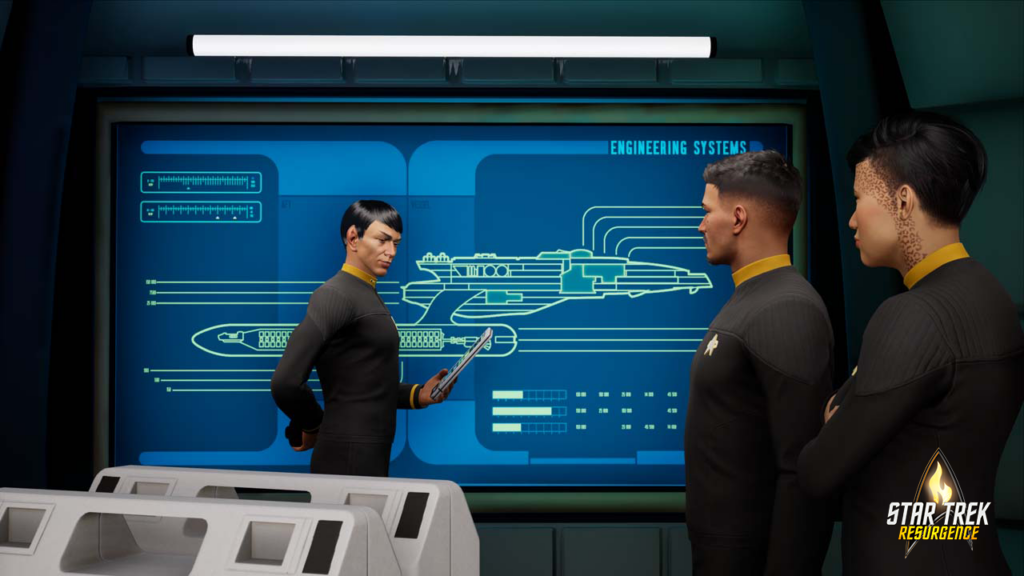The best “Star Trek” story in 2023 was not streamed on Paramount+, but was to be found in a video game by Dramatic Labs: “Star Trek: Resurgence“. Players assume the roles of first officer Jara Rydek and lower decker Carter Diaz. “Resurgence” tells a gripping tale about the starship U.S.S. Resolute and her crew, picking up the virtues of 90’s “Star Trek”, showcasing what a contemporary adaptation of “The Next Generation” can be.
Zur deutschen Übersetzung geht es hier entlang.
TrekZone.de had the opportunity to sit down with Andrew Grant, writer and producer on “Resurgence”, and chat about his approach to storytelling in general and “Star Trek” in particular.
For reasons of length and clarity, the following interview has been edited.
Andrew Grant, Writer of “Star Trek: Resurgence”
TrekZone Network (TZN): Hello Andrew. Like many at Dramatic Labs, you worked for Telltale Games before the company closed in 2018. You took part on big titles such as “The Walking Dead: Season 2”, “Game of Thrones”, and “Batman: The Enemy Within”. Before that, you were a screenwriter in the film industry. Looking back, what were important experiences and touchstones that influenced you as a writer?
Andrew Grant: First, working as a screenwriter can be a rather lonely endeavor. Often you are solely responsible for creative problem-solving and that cuts both ways: it’s empowering in some respects and daunting in others. But when I first joined Telltale and started working in video games, I loved working within a team of incredibly talented writers and designers, all of whom contributed to the success of those projects. It was the creative experience I’d always hoped for yet so rarely experienced in the film industry.
And secondly, building on that collaborative aspect of game development, was the growing realization that a sense of immersion within the narrative world and offering the player agency over and ownership of that experience was far more powerful than anything a linear story could offer. There is power and potential in player-driven narratives. You are allowing players to shape their own unique experience within the bounds of a narrative world that you created. You’re allowing them to define their relationships with other characters and alter the course of events based on the choices they make.
When those elements come together, where the player is left feeling simultaneously haunted by their choices, yet, absolutely convinced they made the right choice as an expression of their values, then the story truly becomes their own.
Real and Fake Choice
TZN: In another interview, you talked about how important it is to disallow wrong player decisions, to not lead them down blind alleys. What compromises need to be made here? Narratives with “hard” branches can lead to an exponential explosion of content production, which is not economically feasible. At the same time, players often lament invisible ‘rubber bands’ pulling the story back on the ‘right track’ despite their decisions. How do you balance this in your day-to-day work?
Grant: It is the perennial problem with player-driven narratives. I personally don’t care for the ‘on rails’ narrative game experience. With every project, we aspire to give the player as much agency and latitude to shape the course of events as possible. But as you noted, it’s not feasible to create an endlessly branching story where you’re grappling with the Tkon in one version and, as an example, the Klingons in another.
There are the obvious production considerations, but my bias as a writer is that the audience wants an immersive experience that is crafted with a great amount of thought and consideration as events progress. That to me is what makes the game memorable and meaningful, where the player has the ability to shape and define relationships and events – and the game will reflect and honor those choices throughout. It is, however, a delicate balance and something we confront on every project.
TZN: The main mechanic for player choice in “Resurgence” is dialog, where players can choose one of three responses. In the interview I mentioned earlier, you talked about how the original trio of Kirk, Spock and McCoy inspired you to craft options along the spectrum between emotional and rational decision making. What else do you consciously think about for crafting interesting choices?
Grant: The truth is that we labor over the choices and continue to hone and refine each choice throughout the writing process. It’s never quite as straightforward as ‘yes / no / maybe’ or ’emotional / rational / wildcard’ because there are so many factors in play in any given scene. First there’s the dramatic structure of a scene, where the stakes are clear; the scene itself has to be entertaining, compelling and meaningful for the player.
Then there are the relationship dynamics with a given character or group of characters. That’s where the Kirk-Spock-McCoy triad is such an apt analogy for “Star Trek: Resurgence” because the player is confronted with these incredibly difficult choices with no single right answer. We know we’ve done our job when players actually pause the game to wrestle with which choice best reflects their character, their values.
And the most important dimension, which I’ve alluded to previously, is that every choice has to be balanced and equally valid. For example, if as First Officer you want to dutifully follow orders and respect the chain of command (or conversely defy orders at every opportunity) the game will both honor and reflect those choices throughout the narrative as events progress. What I love is that players could have diametrically opposed views on the ‘best’ way to play as Jara Rydek or Carter Diaz in the game and they can both be right (and can have radically divergent experiences in their respective playthroughs).
Conflict Among the Crew and Roddenberry’s Box
TZN: Perhaps this is a good time to talk about one of the few quirks some critics have found with the consequences of player decisions. On the whole, I think you struck a near-perfect tone for what we would expect from a Starfleet crew. What didn’t always work for me were the motivations behind some of the conflicts within the crew. While the friction between Carter and Chovak seemed very organic due to cultural and personal differences, I was surprised to learn that the bridge officers got “bruised egos” after I made ship-saving command decisions without following their recommendations.
Many conflicts on the bridge seem to boil down to ambition or even vanity, which I didn’t expect. I guess my question is: How did you wrestle “Roddenberry’s Box” and how did you approach your “breakout”?
Grant: Honestly, I think it’s a fair criticism with regard to some of the ego-driven dynamics of the bridge crew.
Roddenberry’s Box: One of the tenants of “Star Trek: The Next Generation” creator Gene Roddenberry was a strict “no conflict” rule among the Enterprise crew. They were to illustrate the advancements humanity had made into the 24th century, leaving behind mundane sources of conflict such as envy, grief or petty ambition.
Writers, especially on “The Next Generation”, struggled with this rule as it precluded many avenues of drama for the show. Famously, “Deep Space Nine” began to think outside that box, while Ronald D. Moore (one of DS9’s staff producers) later created the revamped series “Battlestar Galactica”, redefining TV drama in a sci-fi setting.
It was something we debated internally throughout the writing process. Where possible, we tried to honor the principles behind ‘Roddenberry’s Box’ as best we could, while also crafting a compelling drama rooted in dimensional yet flawed characters.
Conflict is the essence of drama and in a player-driven narrative you want choices that have clear consequences, so more often than not there will be a bridge officer with an opposing point-of-view who disapproves of your command decision. Navigating those interpersonal dynamics can be both challenging and rewarding for players, but admittedly that meant sometimes we had to bend the rules of ‘Roddenberry’s Box’.
Ultimately, where we landed was that we didn’t want the conflict to feel petty and more often than not those NPCs have moments of redemption later in the story. For example, Commander Westbrook comes off as rather harsh and abrasive when he first meets Jara Rydek on the bridge – which can then be compounded if you don’t follow his advice – and most players take an instant disliking to his character, yet, over time they tend to forgive him and might even come to value his opinion as events progress.
But crafting that narrative arc while also trying to remain true to the spirit of ‘Roddenberry’s Box’ was certainly a challenge.
TZN: Overall, I feel your approach is a restrained update of ‘Roddenberry’s Box’: more in line with the tone and ethos of “The Next Generation” or “Voyager” then what we find in contemporary ‘Star Trek’ shows. I would think that Paramount has given you more leeway. Why stick to something that other contemporary TV writers seem to largely ignore?
Grant: I am a huge fan of some of the more recent series – especially “Strange New Worlds”, which is so incredibly well-written. Paramount gave us a lot of latitude throughout the creative development process and we received expert guidance from Mike Johnson on their team, who proved to be an invaluable resource for all sorts of “Trek” details and nuances.
From the start, TNG was our touchstone and that series in particular informed our approach more than anything else. So, it was less that we wanted to break out of the box and more that we wanted to create a standalone narrative that would feel like an organic fit as its own series or feature-length movie from that era. Essentially, an homage to the elements that hooked us as fans of the franchise from the beginning and that (we hoped) would resonate and ring true with a wider “Trek” audience. The response thus far has been really gratifying, which is a testament to the love and attention to detail from the entire development team.
To be continued…
There’s more. We’ll release the second part of our interview with Andrew Grant Saturday, when we talk about the balance between fan-service and originality, resurrecting Leonard Nimoy’s Spock and the future of both the U.S.S. Resolute and the genre as a whole.
“Star Trek: Resurgence” was released on 23.05.2023 for PC in the Epic Store, along with versions for XBox One, Series X/S, Playstation 4 and Playstation 5. As we write this article, download copies are available for 24,99 €, physical copies for consoles are 29,99 € at online retailers.




